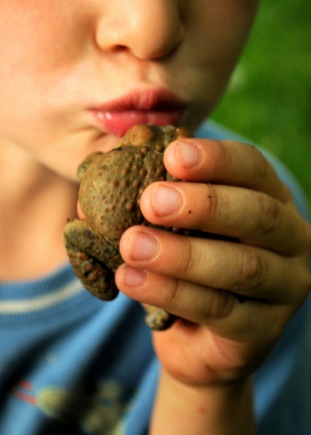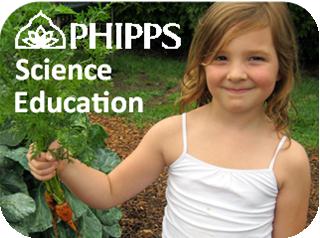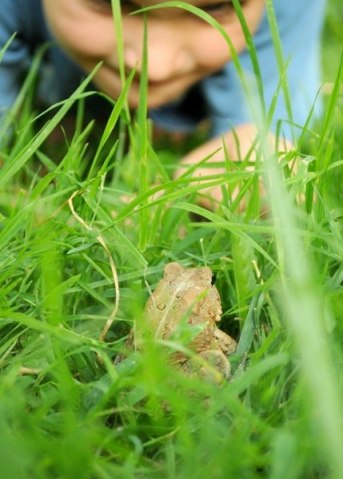If you live by a pond or a stream, there is a certain sound in the air that says spring has sprung – the call of a frogs and toads. Frog and toad calls are not the notorious ‘ribbit’ sounds of children’s books, but rather a rich symphony of calls that are each as distinctive as the creature that makes them. Each species of frog has a different call for mating than for defending territory; some are high-pitched peeps and others sound like the low tones of a banjo. Stand by a pond at night in the Pennsylvania spring and you will hear a raucous chorus of American toads, spring peepers, wood frogs, green frogs and bullfrogs. This spring sing is not only fun to listen to, but is also important to science. Frogs and other amphibians are considered indicator species; they are very sensitive to environmental change and their presence or absence can tell scientists valuable information about the health of an area. In short, it is very good idea to keep an eye on our frogs and toads.
This is where you come in. The North American Amphibian Monitoring Program (NAAMP) and FrogWatch USA are citizen science programs that are designed to help scientists gather data about the health and well-being of the amphibian population. Citizen science programs, in which regular people collect data about the plants and animals in their communities, help scientists to have eyes and ears all over the country. These particular programs are not only important for data collection, but are also a great way to spend some time outside with your family and practice your observation skills. Participating in these two programs are especially easy, since all you need to do is listen.
 Frog watchers don’t need to see the frogs (although that is half the fun), but rather identify them by their mating calls. Learning frog calls is fun and easy, since each one is so unique. There are only a handful of amphibian species in most areas, so there aren’t that many to learn; this is made even easier by a host of online resources that allow you to listen and learn from the comfort of your home. Pick a location that is easy for you monitor, such as a pond near your home, and this will be the spot that you monitor all season. You can sign up with either organization, both of which provide training sessions if you are so inclined. You will need to monitor your spot weekly and record your data in the manner that your organization suggests. Once you are signed up and know your calls, you ready to be a citizen scientist!
Frog watchers don’t need to see the frogs (although that is half the fun), but rather identify them by their mating calls. Learning frog calls is fun and easy, since each one is so unique. There are only a handful of amphibian species in most areas, so there aren’t that many to learn; this is made even easier by a host of online resources that allow you to listen and learn from the comfort of your home. Pick a location that is easy for you monitor, such as a pond near your home, and this will be the spot that you monitor all season. You can sign up with either organization, both of which provide training sessions if you are so inclined. You will need to monitor your spot weekly and record your data in the manner that your organization suggests. Once you are signed up and know your calls, you ready to be a citizen scientist!
Frogs and toads mate at different times of the year, so participants need to monitor their locations all spring and summer. Frog monitoring happens mostly at night, since frogs are more active then, but you can complete your monitoring during the day as well. If you are dedicated in your data collection, you will also reap the benefits of coming to know your area and watching it change through the seasons. You may start to notice birds that nest in nearby trees, the blooming of different flowers and tracks from animals that use your water source for drinking. You may also notice masses of frog and salamander eggs stuck to plants in the water and even baby tadpoles swimming along. Frog monitoring is a great way to experience nature and feel connected to your community.
This is not only a fun project for a family, but also for a scout troop or school class. Training classes are going on now all over the country, so get connected! Here are some helpful links to get you started:
FrogWatch USA: Learn where your local chapter is based, get training, and find helpful ways to learn frog calls.
North American Amphibian Monitoring Project: Learn survey protocol, find your state’s coordinator and take a frog call quiz.
List of Frogs and Toads by State: There are over 100 species of frogs and toads in the country, but only a few near you. Learn which ones live nearby.
Cornell Lab of Ornithology: Learn your frog calls (and even some birds if you want!)
AmphibiaWeb: Frog calls and natural history information for the curious frog watcher.
Interested in other citizen science programs? The Citizen Science Alliance has tons of great projects for people of all interests, from here on earth to outer space!
The above photos are copyrighted to Molly Steinwald.











